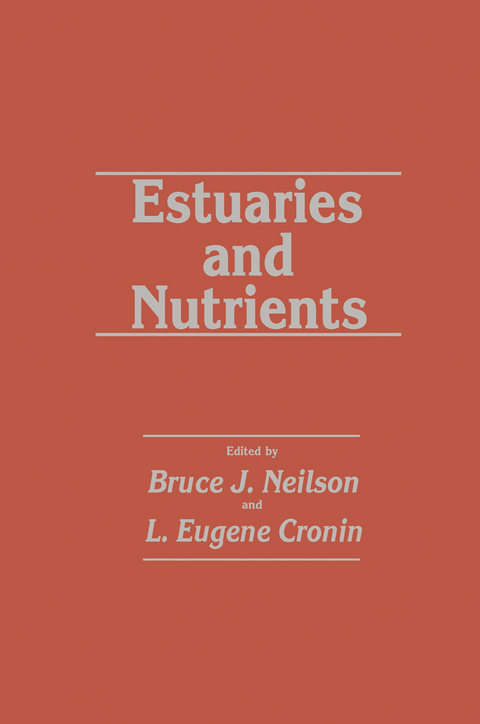
Estuaries and Nutrients
Humana Press Inc. (Verlag)
978-1-4612-5828-5 (ISBN)
Estuaries are eternally enriched. Their positions at the foot of watersheds and their convenience as receiving bodies for the wastes of cites, towns and farms results in continuous addition of nutrients - those elements and compounds which are essential for organic production. Such materials must be added to these complex bodies of water to sustain production, since there is a net loss of water and its contents to the oceans. Enrichment from land and the ocean and the subsequent cycling of the original chemicals or their derivatives contribute to the extraordinarily high values of estuaries for human purposes. Many estuaries are able to assimilate large quantities of nutrients despite the great fluctuations which occur with variations in the flow from tributaries. The nutrients can be stored, incorporated in standing crops of plants, released, cycled and exported - and the system frequently achieves high production of plants and and animals without creation of any undesirable results of enrichment. Excessive enrichment with the same elements and compounds can, however, be highly detrimental to estuaries and their uses. Coastal cities are usually located on the estuaries which provided a harbor for the- and which now receive partially treated sewage and other wastes from the expanding population and industrial activity. Conversion of woodlands to agricultural use and the extensive application of fertilizers have resulted in the flow of large quantities of nutrients down the hill or slopes and eventually into the estuary.
Invited Review Papers.- Special Characteristics of Estuaries.- Conceptual Models and Processes of Nutrient Cycling in Estuaries.- Physical and Geological Processes Controlling Nutrient Levels in Estuaries.- Studies of Eutrophication in Lakes and Their Relevance to the Estuarine Environment.- Sources of Nutrients and the Scale of Eutrophication Problems in Estuaries.- Remineralization and Nutrient Cycling in Coastal Marine Ecosystems.- Uptake of Major Nutrients by Estuarine Plants.- Indicators and Indices of Estuarine Enrichment.- Modeling of Eutrophication in Estuaries.- Nutrient Enrichment and Estuarine Health.- Impact of Nutrient Enrichment on Water Uses.- Management Implications of Nutrient Standards.- Case Studies.- The Effects of Treated Sewage Discharge on the Biota of Port Phillip Bay, Vicotria, Australia.- Estuaries and Coastal Lagoons of South Western Australia.- Eutrophication in the Peel-Harvey Estuarine System, Western Australia.- The Use of Nutrients, Salinity and Water Circulation Data as a Tool for Coastal Zone Planning.- Reversal of the Eutrophication Process: A Case Study.- Responses of Kaneohe Bay, Hawaii, to Relaxation of Sewage Stress.- Contributed Papers.- Nitrification in the Upper Tidal James River.- Eutrophication Trends in the Water Quality of the Rhode River (1971–1978).- Aboveground Net Primary Productivity of Three Gulf Coast Marsh Macrophytes in Artificially Fertilized Plots.- Nitrification and Production of N2O in the Potomac: Evidence for Variability.- Photosynthesis, Extracellular Release, and Heterotrophy of Dissolved Organic Matter in Rhode River Estuarine Plankton.- Enrichment of a Subtropical Estuary with Nitrogen, Phosphorus and Silica.- A Suggested Approach for Developing Water Quality Criteria for Management of Eutrophication.-The Significance of Dredging and Dredged Material Disposal as a Source of Nitrogen and Phosphorus for Estuarine Waters.- The Effects of Sewage Discharge into a Wind-Induced Plume Front.- Application of the OECD Eutrophication Modeling Approach to Estuaries.- Phosphorus and Nitrogen Limited Phytoplankton Productivity in Northeastern Gulf of Mexico Coastal Estuaries.- Contributed Complementary Studies in the York River.- Short Term Changes in the Vertical Salinity Distribution of the York River Estuary Associated with Neap-Spring Tidal Cycle.- Time Varying Hydrodynamics and Water Quality in an Estuary.- Inorganic Nitrogen Regeneration and Total Oxygen Consumption by the Sediments at the Mouth of the York River, Virginia, USA.- Phytoplankton Response to a Stratification-Mixing Cycle in the York River Estuary during Late Summer.- Animal Index.- Plant Index.- Waterbody Index.
| Erscheint lt. Verlag | 21.12.2011 |
|---|---|
| Reihe/Serie | Contemporary Issues in Science and Society |
| Zusatzinfo | X, 643 p. |
| Verlagsort | Totowa, NJ |
| Sprache | englisch |
| Maße | 152 x 229 mm |
| Themenwelt | Sachbuch/Ratgeber ► Natur / Technik ► Garten |
| Naturwissenschaften ► Biologie ► Limnologie / Meeresbiologie | |
| Naturwissenschaften ► Biologie ► Ökologie / Naturschutz | |
| Naturwissenschaften ► Geowissenschaften ► Geologie | |
| Naturwissenschaften ► Geowissenschaften ► Hydrologie / Ozeanografie | |
| ISBN-10 | 1-4612-5828-6 / 1461258286 |
| ISBN-13 | 978-1-4612-5828-5 / 9781461258285 |
| Zustand | Neuware |
| Haben Sie eine Frage zum Produkt? |
aus dem Bereich


